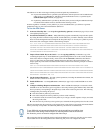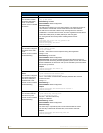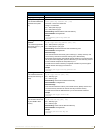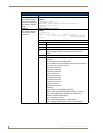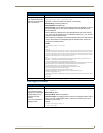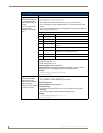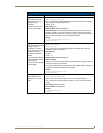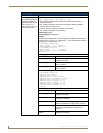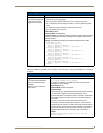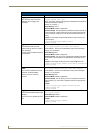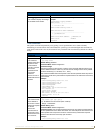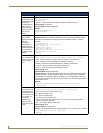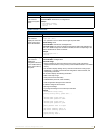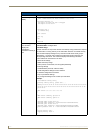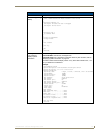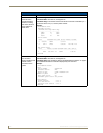
CLI (Command Line Interface)
185
NXA-ENET24 - Software Management Guide
SMTP Alert Commands
Configures SMTP event handling, and forwarding of alert messages to the specified SMTP servers and email
recipients.
Event Logging Commands (Cont.)
Command Function
show log
This command displays the
system and event mes-
sages stored in memory.
Syntax:
• show log {flash | ram} [login] [tail]
• flash - Event history stored in flash memory (i.e., permanent memory).
• ram - Event history stored in temporary RAM (i.e., memory flushed on power
reset).
• tail - Shows event history starting from the most recent entry.
• login - Shows the login record only.
Default Setting: None
Command Mode: Privileged Exec
Command Usage: This command shows the system and event messages stored
in memory, including the time stamp, message level, program module, function,
and event number.
Example: The following example shows sample messages stored in RAM:
Console#show log ram
[5] 00:01:06 2001-01-01
"STA root change notification."
level: 6, module: 6, function: 1, and event no.: 1
[4] 00:01:00 2001-01-01
"STA root change notification."
level: 6, module: 6, function: 1, and event no.: 1
[3] 00:00:54 2001-01-01
"STA root change notification."
level: 6, module: 6, function: 1, and event no.: 1
[2] 00:00:50 2001-01-01
"STA topology change notification."
level: 6, module: 6, function: 1, and event no.: 1
[1] 00:00:48 2001-01-01
"VLAN 1 link-up notification."
level: 6, module: 6, function: 1, and event no.: 1
Console#
SMTP Alert Commands
Command Function
logging sendmail host
This command specifies SMTP
servers that will be sent alert
messages.
Use the no form to remove an
SMTP server.
Syntax:
[no] logging sendmail host ip_address
• ip_address - IP address of an SMTP server that will be sent alert
messages for event handling.
Default Setting: None
Command Mode: Global Configuration
Command Usage:
• You can specify up to three SMTP servers for event handing. However,
you must enter a separate command to specify each server.
• To send email alerts, the switch first opens a connection, sends all the
email alerts waiting in the queue one by one, and finally closes the
connection.
• To open a connection, the switch first selects the server that
successfully sent mail during the last connection, or the first server
configured by this command. If it fails to send mail, the switch selects
the next server in the list and tries to send mail again. If it still fails, the
system will repeat the process at a periodic interval. (A trap will be
triggered if the switch cannot successfully open a connection.)
Example:
Console(config)#logging sendmail host 192.168.1.200
Console(config)#



